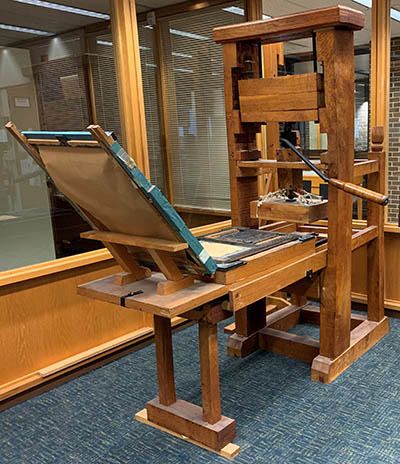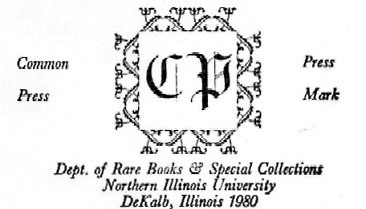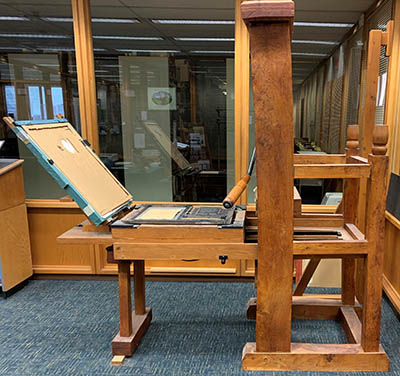- University Libraries
- Special Collections and Archives
- About
- NIU Common Press
NIU Common Press
 The Rare Books and Special Collections department houses a replica of the common press, a wooden hand-press used for printing in the 17th and 18th century. Built in 1976 by Joe Frieders as a senior woodworking project, the seven-hundred-pound machine offers a working example of how some of NIU's rare books were produced. The NIU Common Press has printed pamphlets, Christmas cards, broadside keepsakes and reproduction proofs for various events.
The Rare Books and Special Collections department houses a replica of the common press, a wooden hand-press used for printing in the 17th and 18th century. Built in 1976 by Joe Frieders as a senior woodworking project, the seven-hundred-pound machine offers a working example of how some of NIU's rare books were produced. The NIU Common Press has printed pamphlets, Christmas cards, broadside keepsakes and reproduction proofs for various events.
One of the goals of Rare Books and Special Collections is to resurrect the usage of the press for demonstrations and event printing.
History of the Common Press
The Common Press, an early version of a platen press, was used widely in Europe and the United States in the 17th and 18th centuries. It was also termed the joiner's press because it was constructed entirely of wood. The cheeks of the press often were built into the ceiling to help anchor the mammoth machine. The common press is a "two-pull press"; the movement of the platen down only operates on half of the coffin at a time. Two sets of type may be loaded into the case of the coffin to be printed. Its construction remained nearly unchanged for over 200 years, until the introduction of the metal press, letting the entire coffin to be printed at once.
History of the NIU Common Press
Joe Frieders, a student of the Industry and Technology Department, built the solid oak structure in 1976. After three months of construction, the individual wooden press parts were pegged and glued together in the Rare Books room of Founders Memorial Library.
Anthony Bliss, the Rare Books Librarian at the time, instigated the project as a way to demonstrate how many of the books in the collection were produced. Complete historical accuracy could not be achieved due to certain materials being unavailable. The mechanics of printing, however, are identical.
In addition to the creation of the press, Bliss ordered type that was popular in the era of the wooden hand press. Using this type and donated type as well, Bliss and the Bibliographic Society of Northern Illinois printed various articles on the press from 1976 to 1983. Above is an example of the pressmark, or printed signature from our press.
Basic Press Mechanics
 The simple mechanics of the press involve arranging and inking the type, loading paper, and physically using the press to force the paper and inked type together to make a repeatable impression. It operated on the principle that a steep metal screw would allow pressure to be applied in a swift controlled way, dwell briefly and released. A lever connected to a screw lowers a platen down onto the tympan assembly. The tympan assembly distributes the weight of the engaged platen evenly over the surface of the paper pressing it onto the type or blocks arranged into the coffin.
The simple mechanics of the press involve arranging and inking the type, loading paper, and physically using the press to force the paper and inked type together to make a repeatable impression. It operated on the principle that a steep metal screw would allow pressure to be applied in a swift controlled way, dwell briefly and released. A lever connected to a screw lowers a platen down onto the tympan assembly. The tympan assembly distributes the weight of the engaged platen evenly over the surface of the paper pressing it onto the type or blocks arranged into the coffin.
The common press is a "two-pull press"; the movement of the platen down only operates on half of the coffin at a time. Two sets of type may be loaded into the case of the coffin to be printed.
The Common Press has two moving parts, the carriage and the platen. The horizontal moving part of the press is the carriage. The carriage consists of the tympan that holds paper and the coffin that holds the type. The two parts are connected by a hinge. When the hinge in open, such as in the photo below, the paper can be loaded and unloaded and the type can be arranged or inked. With paper loaded, the printer then folds the hinge closed and winds the carriage forward under the vertical posts of the press. The printer pulls the handle, pressing the type and paper together with even, heavy pressure. The printed page is then unloaded and examined for consistency.
Press Operation
 The operation of the press ideally involves two people. One inks the type (the inker), while the other loads paper and operates the press (the puller). Since it is easy to get one's hands dirty while working with ink, the inker does not handle the paper or the rounce.
The operation of the press ideally involves two people. One inks the type (the inker), while the other loads paper and operates the press (the puller). Since it is easy to get one's hands dirty while working with ink, the inker does not handle the paper or the rounce.
Inking. The inker takes a putty knife and spreads a thin line of ink out onto a flat, clean surface. The inker holds the roller handles on each side and rolls the roller back and forth over the strip of ink, against the flat surface until the roller is evenly covered. This person then rolls the inked roller over the surface to transfer a thin layer of ink to the top of the metal letters.
Loading Paper. The other person, the puller, lifts the frisket and loads paper into the tympan. Points, locked with point screws, prick through the sheet and hold it in place. The pinpricks can be reused to aid in alignment for printing another color or onto the other side. The puller lowers the frisket over the paper, sandwiching the paper between and exposing only areas of the paper to be printed. The puller has already cut the brown paper to expose only the areas necessary to transfer the page. The frisket protects the paper from shifting and the margins from any unwanted ink.
Printing. As soon as an even layer of ink is on the letters, the puller folds the frisket and tympan down onto the coffin. The left hand winds the rounce to position the first set of type under the platen. The right hand moves the lever over to press down the platen and moves the lever back to release it. Using a mark on the bed, the puller rolls the press stone over the second half of the coffin and repeats the lever turn and release.
Unloading Paper. The carriage is returned to the open position with the rounce, the tympan assembly completely unfolded and the freshly inked paper is replaced with a clean sheet.
Repeat. The entire process is repeated with fresh ink and paper for each impression, until the desired number of the finished products is reached. This ability to recreate the exact same page in multiples efficiently is exactly why the press was created.
Glossary of Press Terms
- Broadside - a page with only one side printed
- Carriage -horizontally moving part of the Common press that contains both the tympan assembly and the coffin
- Cheeks - the tallest pair of vertical posts on the Common press
- Coffin - the part of the press that holds type
- Frisket - part of the tympan assembly, the frisket is trimmed paper that covers margins to protect the paper to be printed from stray ink
- Platen - the wooden block that is forced down by a screw onto the paper and inked type to form an impression
- Point screws - screws that attach the points to the tympan assembly
- Points - metal forks with a pin point at the end that prick the paper, holding it in precise alignment puller-person responsible for loading and unloading paper
- Roller - a tube with a handle on each end used to distribute ink evenly over a surface
- Rounce -the wheel that is wound to move the carriage under the platen for printing and then out from underneath to load paper, or load and ink type
- Tympan - press part that distributes the weight of the platen evenly over the coffin to ensure a consistent impression
- Tympan assembly - part of the carriage that holds the paper, consists of the tympan and the frisket
- Type - metal block with a raised surface that reads as a letter or punctuation when stamped on a surface, used in concert to create text
References
Glaister, Geoffery Ashall. Glaister's Glossary of the Book. 2nd ed. University of California Press: Berkeley and Los Angeles, 1979.
Hansard, T.C. Typographia. London: Baldwin, Craddock, and Joy, 1825. London: Gregg Press Ltd, 1966.
Contact Us
Special Collections and ArchivesFounders Memorial Library
Room 403
217 Normal Rd
DeKalb, IL 60115-2828
815-753-9392
bwiles@niu.edu